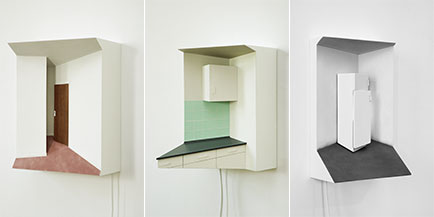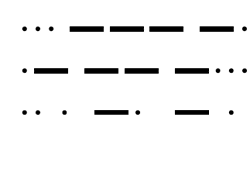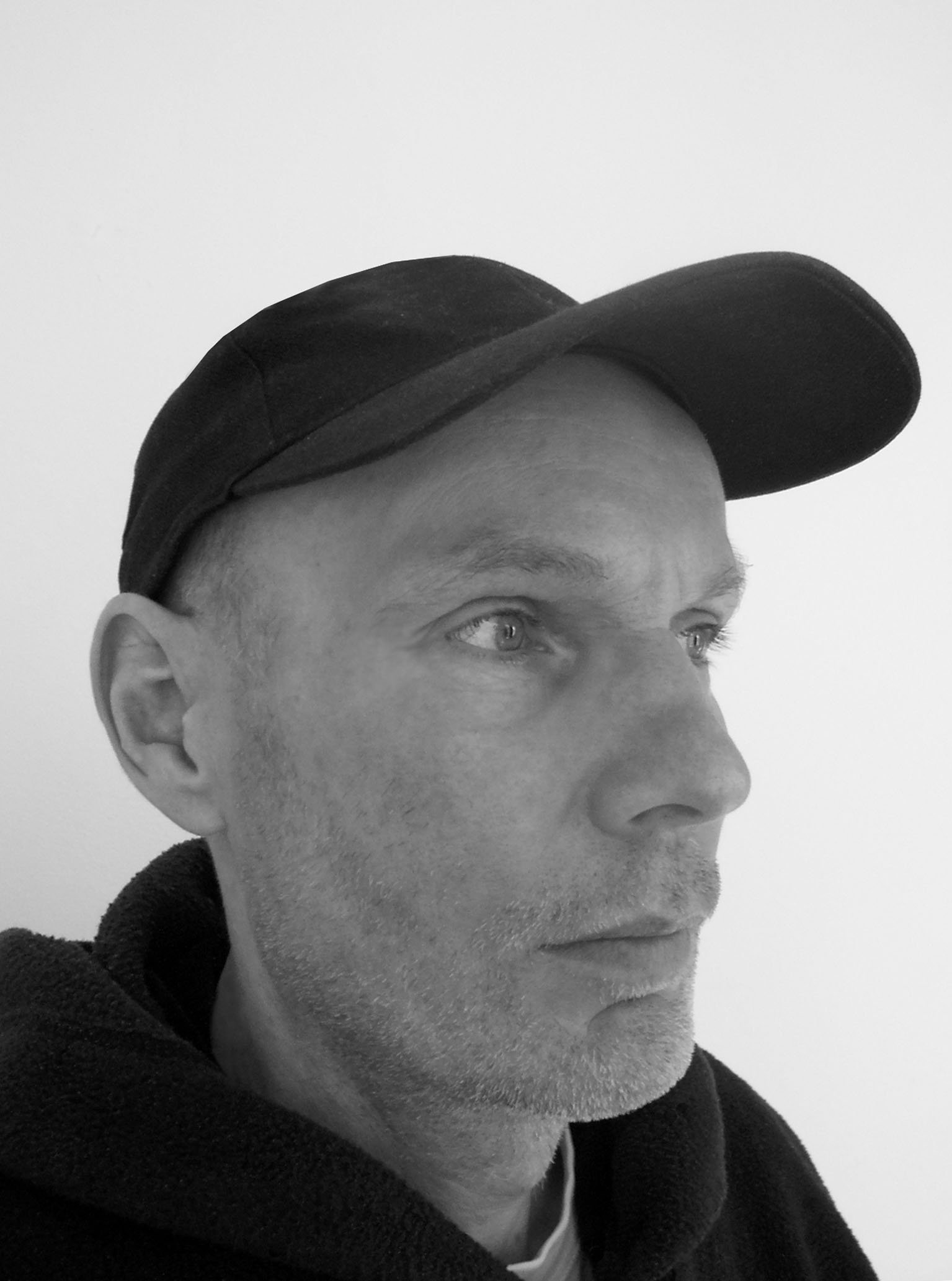| Maurice van Tellingen |
Miniatur-Interieurs 2000-2005 Exhibition
Akademie der Künste am Pariser Platz
Dreidimensionale Gemälde MDF+Holz+Plastik+Farbe+DVD-Player+Monitore.
Mit freundlicher Genehmigung der Ronmandos Galerie Rotterdam.
Dreidimensionale Gemälde MDF+Holz+Plastik+Farbe+DVD-Player+Monitore.
Mit freundlicher Genehmigung der Ronmandos Galerie Rotterdam.

IShower, Gas-stove, Clock, Swimming-bath
shower, Window, Loudspeaker, Kitchen, School, Refrigerator, Hotel [Flos
Wildschut] A television is set up in a prominent spot in the studio
of Amsterdam artist Maurice van Tellingen. The set is switched on. A Hitchcock-like
film is showing on the screen. Maurice van Tellingen is showing me a recent
project, which is not yet completely finished. He meticulously selected all
‘shots’ of ‘house-interiors’ from a stack of B-films
he picked up at a flea market and edited them together, resulting in a new
film. Very soon it becomes clear that this film, consisting of fragments that
are edited together, will have no denouement, but even so I can hardly turn
away from it. The atmosphere of suspense keeps me curious about the next scene.
The fragments seem to tell a story. I hear footsteps. Erotic sighs are smothered
by the sound of a typewriter. An LP is turning slowly on a record player.
Instead of music, I hear a telephone ringing. An old-fashioned fifties sound.
A fire is burning in the fireplace. Excruciatingly slowly, a doorknob is turned.
Something horrible is bound to happen. The clock keeps on ticking. There is
no sign of people; there is only the suggestion of their presence. Somebody
must have lit the fire and put a record on the turntable. The door is not
opened by a mere breeze. And then there are the sounds: the ringing phone
reveals there is a person on the other end of the line.
This recent piece is typical of Maurice van Tellingen's whole oeuvre: the interior is one of his central subjects. In the pieces the interior becomes manifest in the form of small peepshow-like boxes. Maurice van Tellingen himself prefers to call these miniature interiors three-dimensional paintings, but they may also be compared to 17th-century genre paintings. This comparison places Maurice van Tellingen in the Dutch tradition of painting interior scenes, but while the interiors of Johannes Vermeer and Pieter de Hoogh are inhabited, the interiors of Maurice van Tellingen are void of people. None the less, you can sense their presence in Maurice van Tellingen's interiors by means of the subtle use of light and sound, which does not seem to have a natural or a divine source; it is clearly introduced by humans.
Is Maurice van Tellingen trying to show us something that bears an outward resemblance to the truth – which has a strong religious connotation – or is he just trying, in a more down-to-earth way, to mimic reality? Maybe these two desires are merged in his work.
It makes me think of the term presentia realis, which is connected to Greek Orthodox icons. Icons that depict Christ or the apostles are sacred in the Greek Orthodox Church, because the depicted are considered to be present in reality. It also brings Plato's allegory of the cave to mind, which urges some deeper contemplation of this issue. Do we see reality or do we only see a shadow, a derivative of a higher reality.
Do we actually know what reality is? Is it probable that there is only one reality or does every person have his own reality? To what extent can reality be imitated? Building a scale model of reality – or at least trying to build one – may be the best way to grasp an essentially intangible phenomenon. In architecture, mock-ups are relied on as a way to clarify the structure and the spatial characteristics of a building. The scale model is more compact and therefore it creates a more powerful image than the building itself, which cannot be taken in at a single glance.
Although Maurice van Tellingen may prefer to call himself a three-dimensional painter, I choose to place him in the architectural tradition. To me, he is more like an architect of reality; every time you look and listen to his work, he impels you to construct new, personal realities – in your head. And isn't that the seat of reality anyway?
This recent piece is typical of Maurice van Tellingen's whole oeuvre: the interior is one of his central subjects. In the pieces the interior becomes manifest in the form of small peepshow-like boxes. Maurice van Tellingen himself prefers to call these miniature interiors three-dimensional paintings, but they may also be compared to 17th-century genre paintings. This comparison places Maurice van Tellingen in the Dutch tradition of painting interior scenes, but while the interiors of Johannes Vermeer and Pieter de Hoogh are inhabited, the interiors of Maurice van Tellingen are void of people. None the less, you can sense their presence in Maurice van Tellingen's interiors by means of the subtle use of light and sound, which does not seem to have a natural or a divine source; it is clearly introduced by humans.
Is Maurice van Tellingen trying to show us something that bears an outward resemblance to the truth – which has a strong religious connotation – or is he just trying, in a more down-to-earth way, to mimic reality? Maybe these two desires are merged in his work.
It makes me think of the term presentia realis, which is connected to Greek Orthodox icons. Icons that depict Christ or the apostles are sacred in the Greek Orthodox Church, because the depicted are considered to be present in reality. It also brings Plato's allegory of the cave to mind, which urges some deeper contemplation of this issue. Do we see reality or do we only see a shadow, a derivative of a higher reality.
Do we actually know what reality is? Is it probable that there is only one reality or does every person have his own reality? To what extent can reality be imitated? Building a scale model of reality – or at least trying to build one – may be the best way to grasp an essentially intangible phenomenon. In architecture, mock-ups are relied on as a way to clarify the structure and the spatial characteristics of a building. The scale model is more compact and therefore it creates a more powerful image than the building itself, which cannot be taken in at a single glance.
Although Maurice van Tellingen may prefer to call himself a three-dimensional painter, I choose to place him in the architectural tradition. To me, he is more like an architect of reality; every time you look and listen to his work, he impels you to construct new, personal realities – in your head. And isn't that the seat of reality anyway?


